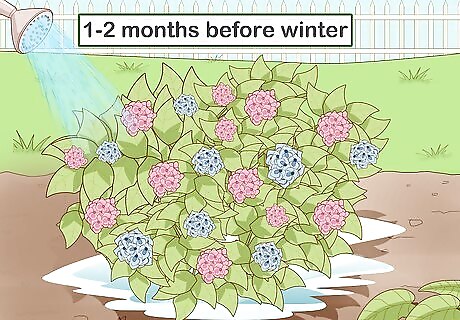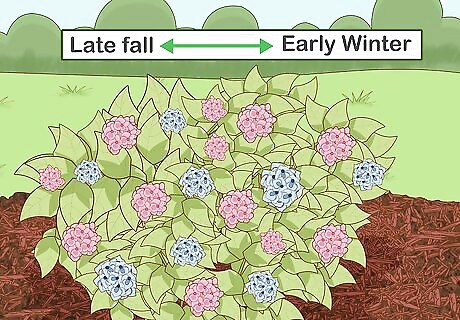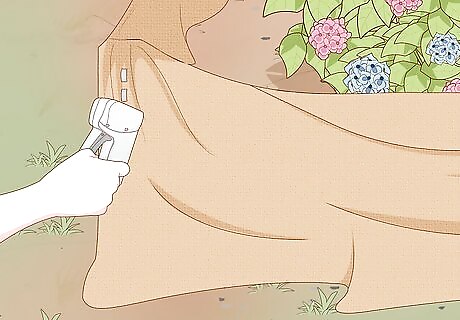
views
Fortifying the Hydrangeas

Fertilize the soil around the plant in mid-summer. It is ideal to fertilize your hydrangea plants in the spring or summer so that new blooms can prosper in the warm weather. Fertilizing your hydrangea plants too close to winter will encourage the growth of new, fragile blooms that will be vulnerable in the cold. Avoid feeding your plants in the fall so they have a better chance of withstanding winter conditions. Applying too much fertilizer at any time of the year may help the plant's leaves grow while hindering its flowers from blooming in the spring.

Add 2–3 inches (5.1–7.6 cm) of compost in the fall to feed hydrangeas in the spring. Compost breaks down slowly, so applying it in the fall will give your plants nutrients in the spring when they need them. Apply a 2–3 in (5.1–7.6 cm) layer of compost to the top of the soil. Using a rake or hand rake, gently till the compost into the top of the soil. If the ground has already frozen, lay the compost on top of it. It will break down over the winter and be ready for your plants in the spring. Make your own compost with materials like fruit and vegetable scraps, coffee grounds, paper, leaves, and grass cuttings.

Water the plants thoroughly every few days before the ground freezes. Hydrangea plants need ample amounts of water to keep them hydrated and healthy. To prepare the plants for cold weather, water them deeply in the late fall. Saturate the root area with water every 2-3 days and allow it to sink into the soil gradually to reach the base of the plant. Start doing this in the fall, 1-2 months before winter. Watering the plants deeply in the fall will give them extra moisture before winter.
Laying Down Mulch

Prepare organic mulch materials. Placing organic mulch around the base of your hydrangeas will protect the roots and the stems of the plant from harsh weather while keeping some moisture in the soil. The best mulch materials for this purpose include straw or fallen leaves. Purchase straw and collect leaves in the fall to use as mulch. Make sure that your mulch materials are free of insects since bugs such as aphids and beetles may harm your hydrangeas. EXPERT TIP Steve Masley Steve Masley Home & Garden Specialist Steve Masley has been designing and maintaining organic vegetable gardens in the San Francisco Bay Area for over 30 years. He is an Organic Gardening Consultant and Founder of Grow-It-Organically, a website that teaches clients and students the ins and outs of organic vegetable gardening. In 2007 and 2008, Steve taught the Local Sustainable Agriculture Field Practicum at Stanford University. Steve Masley Steve Masley Home & Garden Specialist If you're using leaf mulch, let it break down for a while, then sift it. To sift mulch, place it on a screen and shake the screen so the smaller particles fall through. That way, the bigger, coarser fibers will stay on the screen and you'll be left with a nice, fine material. You can then either mix it in with your soil to enrich it, or spread it on top of the soil as mulch.

Apply the mulch in late fall or early winter, or once the ground is frozen. Laying mulch while it is still relatively warm out is likely to attract rodents who are preparing their winter shelter, and may cause rotting and disease in your hydrangea plants. If you live in a very cold climate, wait until the ground freezes to lay down mulch. In warmer climates, wait until at least the late fall. In very cold climates, mulching may not be necessary as other more extensive sheltering from winter conditions may be required.

Lay down 6–8 inches (15–20 cm) of mulch around the plant base. Hydrangeas require a thick layer of mulch to protect them properly throughout the winter. Scatter your mulch materials to cover the ground around the base of your plants. Make sure that the mulch is at least 6 inches (15 cm) high.
Building a Shelter

Insert stakes into the ground at least 4 inches (10 cm) from the plant. Using a hammer or a mallet, drive 4 wooden stakes vertically into the ground around all sides of the plant. The stakes should be placed at a distance of at least 3–4 inches (7.6–10.2 cm) from the base of the plant. Drive the stakes at least 3–4 inches (7.6–10.2 cm) into the ground to make sure they are secure. The stakes should be as tall as your plant. Do not allow the branches of your plant to rest on the stakes. Start building the shelters about a month before the first expected frost.

Wrap burlap around the stakes to create a "cage" for your hydrangeas. While your hydrangea plants need protection for winter conditions, they also need steady air circulation. Be sure to choose a material for your plant "cages" that will allow air to flow through easily, such as burlap. Wrap the material around the outside of the wooden stakes until the circle is closed. Garden fleece is an alternative to burlap that can be found at most garden centers or online.

Staple the fencing material to the stakes with a staple gun. Attach the top, middle, and bottom of each stake to the breathable material wrapped around it. Position the mouth of your staple gun directly over the cage material and wood behind it. Press the trigger of the staple gun to insert the staples firmly into the wood. If you don't secure the material to the wooden stakes, heavy snow or wind could remove the cage.

Fill the enclosure with leaves if you live in a very cold climate. If you expect harsh, cold conditions over the winter, add extra insulation to your hydrangea plant. Fill the "cage" to the top with leaves so that your plant is completely surrounded. The leaves will protect your hydrangea plant from the cold without weighing it down or damaging it. Adding mulch to the base of your plant will not be necessary if you do this step. Pine needles may be used as an alternative to leaves.




















Comments
0 comment